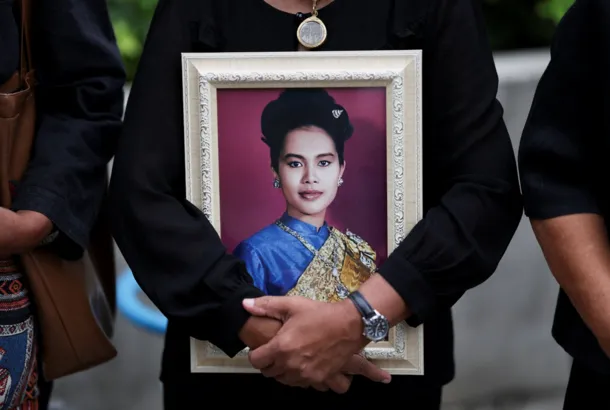


Honoring Queen Sirikit
When people talk about Thailand’s culture, it’s impossible not to mention Queen Sirikit. She wasn’t just a queen. She was a daughter, a wife, a mother and most of all a quiet force of care and beauty. She walked through villages and palaces with the same grace. In October 2025, at the age of 93, she passed away peacefully. But her story didn’t end there. It still lives in the way Thailand dresses, creates and welcomes visitors.


From a Family of Diplomats to the Heart of the Nation
The Beginning of a Royal Story Sirikit Kitiyakara entered the world in 1932 when Bangkok became her birthplace. The environment of her family life taught her to learn while developing her understanding of international perspectives. She spent her early years studying music and languages throughout different European nations. She encountered King Bhumibol Adulyadej during her time in Paris. He started his relationship with her during his Swiss recovery period. The couple demonstrated their commitment through their relationship which showed both unity and dedication.
She became Queen of Thailand after their wedding took place in 1950. Just a few years later, in 1956, she was named Queen Regent while the King entered a temporary monkhood. It was a role filled with responsibility and trust. People viewed this moment as proof of her inner power and unassuming self-assurance.
Her Hands Were Always Close to the People
Support That Changed Lives
Queen Sirikit maintained constant contact with regular people throughout her entire life. She spent many trips to rural areas where she spoke with farmers and artisans to discover solutions for assistance. She established the SUPPORT Foundation when she started it in 1976. The program worked to defend local community traditional crafts while creating economic security for its members. Her love for Thai silk went past following current fashion styles. The program created enduring possibilities for weavers who operated from small rural communities. The promoted colors and textures of her design appeared in both official diplomatic buildings and her fashion shows. The tools operated through controlled systems which their developers maintained complete authority over. This wasn’t charity. It was dignity.
More Than Style — A Sense of Identity
Queen Sirikit supported the official use of traditional Thai clothing during official ceremonies and state functions. She assisted designers in uniting traditional patterns with contemporary sophisticated design components. Thai women looked up to her as a symbol of elegance because she presented herself with dignity through both her clothing and her body language. She developed the values of an entire generation through her work on health projects and Red Cross campaigns and school programs and cultural events.
Places Where Her Spirit Still Lives
In Bangkok and Beyond The Queen Sirikit Museum of Textiles in Bangkok provides visitors with an outstanding chance to learn about her cultural background. The location of this site exists near the Grand Palace because fabric at this location shares historical accounts. The museum displays her clothing collection while showing visitors the silk production process. The space generates a peaceful environment through its elegant design which produces deep emotional effects. The Queen Sirikit Botanic Garden in Chiang Mai serves as a memorial to her dedication to environmental protection and educational facility development. The walkways extend beneath tree canopies while greenhouses display their orchid flowers. The area provides a peaceful atmosphere which allows visitors to wander at their own comfortable speed.
Mother’s Day in Thailand
August 12 is her birthday and also Mother’s Day in Thailand. It’s a day filled with soft blue colors and jasmine flowers. Schools hold celebrations and children give garlands to their mothers. The atmosphere is tender and emotional — a reminder of how personally the country saw her role as Queen Mother.
A Few Gentle Guidelines
Visitors to Thailand who want to see temples and museums and royal sites should follow these recommendations. Dress modestly with covered shoulders and knees Speak quietly and turn off flash photography. Watch for signs near cultural exhibits — not everything should be touched. All people need to stand up and stop their activities when national songs or royal tributes occur. Support local artisans and ask about the origins of their work. The basic process enables you to participate in the story instead of watching it from outside.
When Culture Meets the Coast
Many travelers come for the beaches — and that’s a beautiful part of Thailand. Your travel experience will become more complete by adding one or two cultural sites to your itinerary. On Phuket, after a day by the sea, consider an evening cultural show that highlights Thai dance and costume. Your day in Bangkok begins at the Textile Museum before you watch the river sunset. Queen Sirikit supported maintaining equilibrium between cultural heritage and innovation and between urban and rural ways of life and between refined beauty and compassionate understanding. Your journey should mirror the same essence that defines you.
What Her Life Means for Travelers Today
The legacy of Queen Sirikit isn’t about looking back. The experience reveals new aspects of the current moment. She demonstrated that care and beauty and attention can exist within regular daily activities. Her life story shows foreign visitors the authentic Thai experience through her approach to living life at ease while building genuine relationships with people and places. You can discover her presence throughout your journey when you explore with both an open heart and an inquisitive mind. The temple environment becomes silent as I encounter the silk fabric which meets my friendly greeting. You will likely transport a small fragment of her cultural background to your house without being aware of it.
Recommended tours
Other posts
-
24.12.2025
-
24.12.2025
-
24.12.2025
-
24.12.2025
-
24.12.2025
-
24.12.2025
-
24.12.2025
-
24.12.2025
-
24.12.2025





























